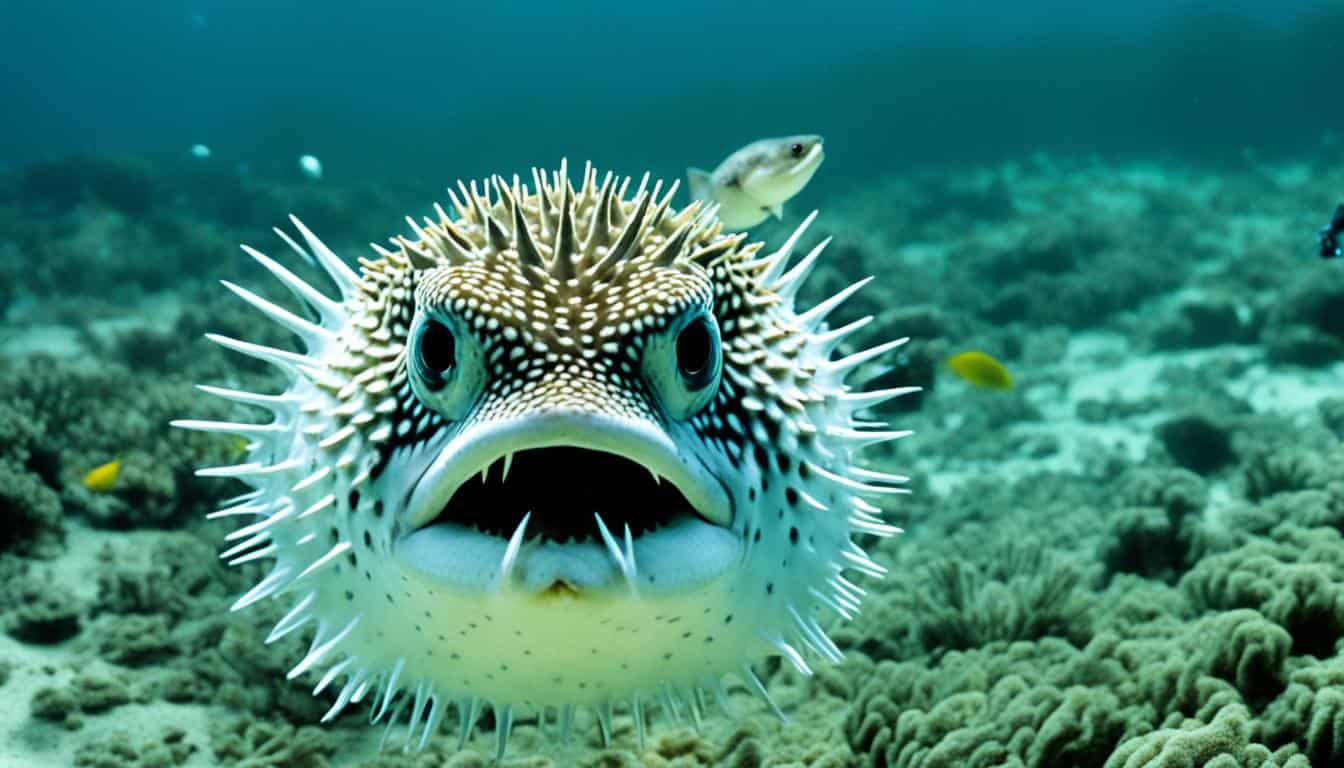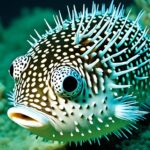Pufferfish, part of the family Tetraodontidae, are fascinating marine creatures. They are well-known for their unique defense strategies. One of the most remarkable features is how they use toxins to protect themselves from predators.
When threatened, pufferfish inflate their bodies, making them bigger. This deters attackers. They also have a potent toxin called tetrodotoxin. This toxin makes them not only unappealing but also dangerous to potential threats.
This pufferfish toxic defense strategy helps them survive in their underwater habitat. It shows how these creatures have evolved to protect themselves.
Pufferfish Overview and Distribution
Pufferfish are fascinating marine creatures in the Tetraodontidae family. They come in over 120 species, showing a wide variety. Learning about the different types of pufferfish helps us appreciate these unique fish and their roles in nature.
Types of Pufferfish
There are both marine and freshwater pufferfish. Examples include the Mbu Puffer and the Sphoeroides variants. Each type has unique features like color patterns and spines. These warn predators of their potential toxicity.
Habitat and Geographic Range
Pufferfish live in various places, from tropical oceans to freshwater areas. They are found in the Pacific and Atlantic oceans. They prefer places with lots of food and shelter, like coral reefs and estuaries.
Their home is crucial for their survival. We must be aware of the dangers of losing their habitat and harming the environment. This affects certain pufferfish species.
Pufferfish Toxins: Tetrodotoxin Explained
Tetrodotoxin is a very powerful toxin found in nature. It is mainly linked to pufferfish, which have unique ways to defend themselves. Knowing about tetrodotoxin is key for those into marine biology or who eat exotic seafood.
What is Tetrodotoxin?
Tetrodotoxin is a toxin found in some sea creatures, especially pufferfish. It works by blocking signals in nerve cells. This toxin is so strong that a tiny amount can be deadly. In fact, it’s said to be 1,200 times more poisonous than cyanide.
Effects of Tetrodotoxin on the Human Body
If you eat something with tetrodotoxin, you might start feeling bad very quickly. Symptoms can include:
- Severe stomach problems
- Feeling numb or paralyzed
- Heart issues like irregular beats
- Not being able to breathe
If you eat something with pufferfish toxins, it could be deadly. Getting help right away is very important if you have these symptoms.

| Symptoms | Severity Level |
|---|---|
| Gastrointestinal Distress | Moderate |
| Numbness and Paralysis | High |
| Arrhythmias | High |
| Respiratory Failure | Critical |
Knowing about tetrodotoxin can help you make safer choices when eating pufferfish and its toxins.
How do pufferfish use their toxins?
Pufferfish have a smart way to defend themselves with toxins. They use a powerful substance called tetrodotoxin to keep predators away. This makes them less appealing to many potential attackers. They can also puff up their bodies, making them even harder to catch.
Toxin as a Defense Mechanism
Pufferfish use toxins and physical defenses to stay safe. When they feel threatened, they puff up. This makes it hard for predators to eat them. The puffing up warns predators and the spines on their bodies can hurt those who try to catch them.
This mix of toxin and behavior helps pufferfish stay safe in the ocean. It shows how physical and chemical defenses work together in nature. This approach helps them survive and shows the complex ways animals defend themselves.
| Defense Mechanism | Description |
|---|---|
| Tetrodotoxin | A potent neurotoxin that deters predators through its lethal effects. |
| Body Inflation | Ability to enlarge significantly, making them harder to swallow. |
| Spines | Physical deterrents that can inflict injury and discourage attacks. |
Understanding the Pufferfish Toxin Production Mechanism
Pufferfish can produce toxins thanks to a complex process involving external sources. At the heart of this is a symbiotic relationship with bacteria. These bacteria help make tetrodotoxin, a powerful neurotoxin. By looking at how pufferfish and their bacteria work together, along with their diet, we can understand their toxic defenses.
Symbiotic Relationships with Bacteria
Research highlights certain bacteria, like Pseudomonas and Vibrio, as key in making toxins in pufferfish. These bacteria live in the pufferfish’s environment and make tetrodotoxin. This toxin builds up in the fish’s tissues. This shows that pufferfish survival and toxicity depend on the bacteria around them.
Diet and Accumulation of Toxins
Knowing what pufferfish eat helps us understand how they store toxins. They eat invertebrates that have toxins. Feeding them the liver of toxic pufferfish helps them absorb and keep toxins, boosting their defense.
Some genetic traits also let pufferfish handle high tetrodotoxin levels. This helps them keep toxins over time. The link between their diet and bacteria is key to their place in the ocean.
FAQ
How do pufferfish use their toxins for protection?
Pufferfish use a powerful toxin called tetrodotoxin to protect themselves. They eat things that have this toxin, making them taste bad and even deadly to predators. This keeps them safe in places where they face many dangers.
What is the mechanism behind pufferfish toxin production?
Pufferfish get their toxins from bacteria that live with them. These bacteria make the toxin, which the pufferfish eat from other animals. This helps the pufferfish stay very toxic but keeps them safe from the toxin’s effects.
What are the effects of tetrodotoxin on humans?
Tetrodotoxin is very dangerous for humans. It’s even more poisonous than cyanide. Just a little bit can cause serious problems like stomach pain, brain issues, and heart problems. If not treated quickly, it can lead to death.
What adaptations help pufferfish survive despite their toxins?
Pufferfish have special genes that let them handle a lot of tetrodotoxin. This helps them keep the toxin and use it to protect themselves from predators.
How do pufferfish inflate themselves as a defense strategy?
When pufferfish feel threatened, they puff up a lot. This makes them bigger and harder to swallow. With their toxins, they become even more difficult for predators to eat, helping them stay safe.
In what environments can pufferfish be found?
Pufferfish live in warm and tropical waters all over the world. Some can even be found in brackish or fresh water. They are found in oceans from the Pacific to the Atlantic, especially where people eat seafood, like in Japan.
What is the role of the pufferfish diet in toxin accumulation?
What pufferfish eat is key to how they get their toxins. They eat animals that have the bacteria needed to make tetrodotoxin. This way, they get the toxin and keep it in their bodies.







